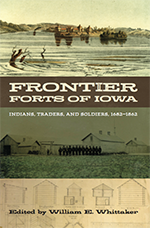Iowa's Archaeological Past
“Iowa's Archaeological Past is directed toward the interested public and should also find a wide audience among professionals and avocational archaeologists in Iowa and beyond."—Donna C. Roper, American Antiquity
“Distilling information from hundreds of archaeological studies, [Lynn Alex] builds a fascinating story of thirteen thousand years of human achievement, adaptability, resilience, interaction, and survival. This book is indispensable for archaeologists, historians, educators, and everyone interested in the native peoples of Iowa and surrounding regions.”—William Green, state archaeologist of Iowa
“Encapsulated here are the thousands of years that American Indians have lived in Iowa along with examples of historic Euro-American and African American settlements. This gold standard will be the authoritative reference on Iowa archaeology long into the twenty-first century.”—David M. Gradwohl, founder, Iowa State University Archaeological Laboratory
Iowa has more than eighteen thousand archaeological sites, and research in the past few decades has transformed our knowledge of the state's human past. Drawing on the discoveries of many avocational and professional scientists, Lynn Alex describes Iowa's unique archaeological record as well as the challenges faced by today's researchers, armed with innovative techniques for the discovery and recovery of archaeological remains and increasingly refined frameworks for interpretation.
The core of this book—which includes many historic photographs and maps as well as numerous new maps and drawings and a generous selection of color photos—explores in detail what archaeologists have learned from studying the state's material remains and their contexts. Examining the projectile points, potsherds, and patterns that make up the archaeological record, Alex describes the nature of the earliest settlements in Iowa, the development of farming cultures, the role of the environment and environmental change, geomorphology and the burial of sites, interaction among native societies, tribal affiliation of early historic groups, and the arrival and impact of Euro-Americans. In a final chapter, she examines the question of stewardship and the protection of Iowa's many archaeological resources.
Preface
Acknowledgments
Introduction
1. The Science of Archaeology
2. History of Iowa Archaeology
3. Iowa Landscapes
4.Paleoindian Discoveries
5. Archaic Developments
6.Woodland Innovations
7. Late Prehistoric Great Oasis
8. Late Prehistoric Mill Creek
9. Late Prehistoric Glenwood
10. Late Prehistoric Oneota
11. Protohistoric and Early Historic Sites Archaeology
12. Stewardship: The Eleventh Hour
Glossary
Bibliography
Index





